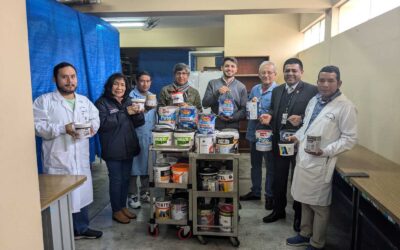Blog
Lead Exposure Elimination project
Donate
Newsletter
Latest updates
2024 in Review
Introduction from LEEP’s Co-Executive Directors 2024 was an exciting year for LEEP, as well as the wider field of actors working on lead poisoning. We continued to scale our lead paint programs, supporting governments and industry to eliminate lead paint from...
Paint study and steps toward lead-free paint in Peru
Summary In October 2024, the General Directorate of Environmental Health and Food Safety (DIGESA), an agency of the Ministry of Health (MINSA), and LEEP conducted a paint study to assess the availability of lead paint on the market in Peru. The results showed that 16...
Paint study and regulation in Burundi
Summary LEEP and two government partners in Burundi conducted a study to determine the lead content of paints in Burundi. The results showed that 13 out of 47 (27%) samples of paints for home use contained hazardous levels of lead (greater than 90 ppm). LEEP, the...
Paint study and workshop in Niger
Summary The State of Niger, through the Ministry of Environment and the Ministry of Public Health, in partnership with LEEP, conducted a study in 2022 to determine the lead content in paints available on the Nigerien market. The results showed that 15 out of 49 (31%)...
Major steps forward on lead paint regulation in Côte d’Ivoire
Summary In September 2023, a paint study was jointly conducted in Côte d'Ivoire by LEEP and the African Center for Environmental Health (CASE), at the request of the Ministry of Health through the Directorate of Public Hygiene and Environmental Health (DHPSE). Results...
Lead paint regulation and standard in Nigeria
Summary In July 2023, LEEP awarded a grant to Sustainable Research and Action for Environmental Development (SRADev Nigeria) to support lead paint elimination in Nigeria through government advocacy and industry engagement. In October 2023, SRADev Nigeria held an...
Zimbabwe: government and paint manufacturers take steps towards lead-free
Summary In June 2023, the Environmental Management Agency of Zimbabwe (EMA) and LEEP jointly conducted a paint study to determine the lead content of paints available to purchase in Zimbabwe. Results showed that 35% of the samples, representing 34 brands, contained...
Update on lead paint in Ghana
Summary The Ghana Environmental Protection Agency, Ghana Standards Authority, Environmental Youth Action Network and LEEP conducted a study to determine the lead content of paints in Ghana. The results showed that six out of 59 (10%) samples of paints for home use...
How cost-effective are LEEP’s paint programs?
LEEP developed its first cost-effectiveness analysis (CEA) in 2021, in which we estimated the expected cost per disability-adjusted life year (DALY)-equivalent averted of implementing our first paint program. As LEEP has expanded its programming over the past few...
Testing spices for lead content in Türkiye and Ethiopia
Summary: LEEP conducted studies to determine the lead content of spices in Türkiye and Ethiopia Spices are a commonly adulterated food product and studies have previously demonstrated the addition of lead chromate pigments in some spice supply chains Results from two...
2023 in Review
Introduction from LEEP’s Co-Executive Directors 2023 has been a year of progress, learning, and growth, all towards our founding goal of improving the health, wellbeing, and potential of children around the world. As we’ve expanded our paint programs, which aim...
New study and industry workshop in Senegal
The Senegalese Ministry of Health, through the Poison Control Centre (PCC), and LEEP recently conducted a study to determine the lead content of paints on the market in Senegal. Results showed that 10 out of 35 (29%) samples of paint for home use, obtained in Dakar,...
Malawi follow-up study results
Summary LEEP and the Malawi Bureau of Standards conducted a new study to assess recent changes in lead paint levels in Malawi. Taking into account estimated market share data, the results suggest that the market share of brands selling lead paint for home use has...
Lead paint workshop in Angola following new study results
Summary: Instituto Nacional de Gestão Ambiental (INGA), EcoAngola and LEEP recently conducted a study to determine the lead content of paints in Angola. Results showed that 18 out of 43 (42%) samples of solvent-based paint and 2 out of 7 (29%) samples of water-based...
Progress on lead paint in Pakistan
Summary: Lead poisoning from paint and other sources affects approximately 47 million children in Pakistan. 40% of oil-based paints for residential use tested by LEEP and Aga Khan University in Pakistan contained dangerous and illegal levels of lead. LEEP is working...
LEEP’s Second Year in Review
Introduction from LEEP’s Co-Executive Directors LEEP was founded on an ambitious goal: to improve the health, wellbeing, and potential of as many children as possible. This goal has always been grounded by the belief that progress is possible if we are committed to...
New published study: Lead levels of new solvent-based household paints in Zimbabwe and Botswana
Summary: a new journal article presents the results of LEEP’s paint studies in Zimbabwe and Botswana, conducted in collaboration with academics from the Paediatric Association of Zimbabwe and University of Zimbabwe.
Testing paint for lead content in Sierra Leone
Summary: LEEP and the Environment Protection Agency of Sierra Leone (EPA-SL) recently conducted a study to determine the lead content of paints in Sierra Leone. Results showed that 9 out of 19 (47%) samples of solvent-based paint for home use, obtained in Freetown,...
How Much Economic Productivity Does Lead Exposure Cost the World?
Lead exposure harms children’s wellbeing via three main pathways: (1) by damaging major organ systems, reducing their physical wellbeing; (2) by causing brain damage in particular, inducing mental health problems and behavioral disorders and thus reducing their mental...
Testing paint for lead content: study results in Madagascar
In June 2021, the Madagascar Ministry of Environment and Sustainable Development, in collaboration with the Ministry of Public Health, the National Center for Environmental Research and LEEP conducted a paint testing study to determine the lead content of paints...



















